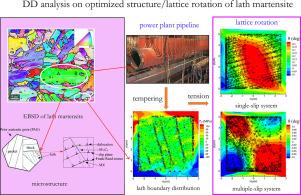Discrete dislocation analysis on lattice rotation of optimized lath martensite
IF 9.4
1区 工程技术
Q1 ENGINEERING, MECHANICAL
International Journal of Mechanical Sciences
Pub Date : 2025-09-30
DOI:10.1016/j.ijmecsci.2025.110882
引用次数: 0
Abstract
Plastic deformation of tempered lath martensitic steel (P91) is investigated with discrete dislocation plasticity method. Geometrically necessary dislocations (GND) are placed within an elastic crystal to model the effect of martensitic phase transformation. The optimized microstructure and formation of lath boundaries are investigated with discrete dislocation plasticity method. Slip system orientations and particles/inclusions such as and MX are considered to reveal their effects on lattice rotation and formation of lath size and boundary. Tension of optimized martensitic crystal is carried out to investigate the motion of lath boundary and the resultant lattice rotation. It is found that lattice rotates not only towards theoretical [101] direction but also to the opposite direction [100] in tension due to aggregation of dislocations, which is consistent with experimental results. Hall–Petch relation does not hold for low-angle-boundary laths, because block is the smallest unit with high-angle boundaries to determine the overall mechanical response. The role of slip system angle, source and obstacle densities on the global stress–strain behaviours are examined.

优化板条马氏体晶格旋转的离散位错分析
采用离散位错塑性方法研究了回火板条马氏体钢(P91)的塑性变形。几何上必要的位错(GND)被放置在弹性晶体中,以模拟马氏体相变的影响。采用离散位错塑性方法对优化后的组织和板条边界的形成进行了研究。考虑滑移体系取向和M23C6和MX等颗粒/夹杂物对晶格旋转和板条尺寸和边界形成的影响。对优化后的马氏体晶体进行张力分析,研究板条边界的运动和由此产生的晶格旋转。发现由于位错聚集,晶格在张力作用下不仅向理论方向[101]旋转,而且向相反方向[100]旋转,这与实验结果一致。对于低角度边界板条,Hall-Petch关系不成立,因为块体是决定整体力学响应的最小单元,具有高角度边界。研究了滑移系统角度、源密度和障碍物密度对整体应力-应变特性的影响。
本文章由计算机程序翻译,如有差异,请以英文原文为准。
求助全文
约1分钟内获得全文
求助全文
来源期刊

International Journal of Mechanical Sciences
工程技术-工程:机械
CiteScore
12.80
自引率
17.80%
发文量
769
审稿时长
19 days
期刊介绍:
The International Journal of Mechanical Sciences (IJMS) serves as a global platform for the publication and dissemination of original research that contributes to a deeper scientific understanding of the fundamental disciplines within mechanical, civil, and material engineering.
The primary focus of IJMS is to showcase innovative and ground-breaking work that utilizes analytical and computational modeling techniques, such as Finite Element Method (FEM), Boundary Element Method (BEM), and mesh-free methods, among others. These modeling methods are applied to diverse fields including rigid-body mechanics (e.g., dynamics, vibration, stability), structural mechanics, metal forming, advanced materials (e.g., metals, composites, cellular, smart) behavior and applications, impact mechanics, strain localization, and other nonlinear effects (e.g., large deflections, plasticity, fracture).
Additionally, IJMS covers the realms of fluid mechanics (both external and internal flows), tribology, thermodynamics, and materials processing. These subjects collectively form the core of the journal's content.
In summary, IJMS provides a prestigious platform for researchers to present their original contributions, shedding light on analytical and computational modeling methods in various areas of mechanical engineering, as well as exploring the behavior and application of advanced materials, fluid mechanics, thermodynamics, and materials processing.
 求助内容:
求助内容: 应助结果提醒方式:
应助结果提醒方式:


